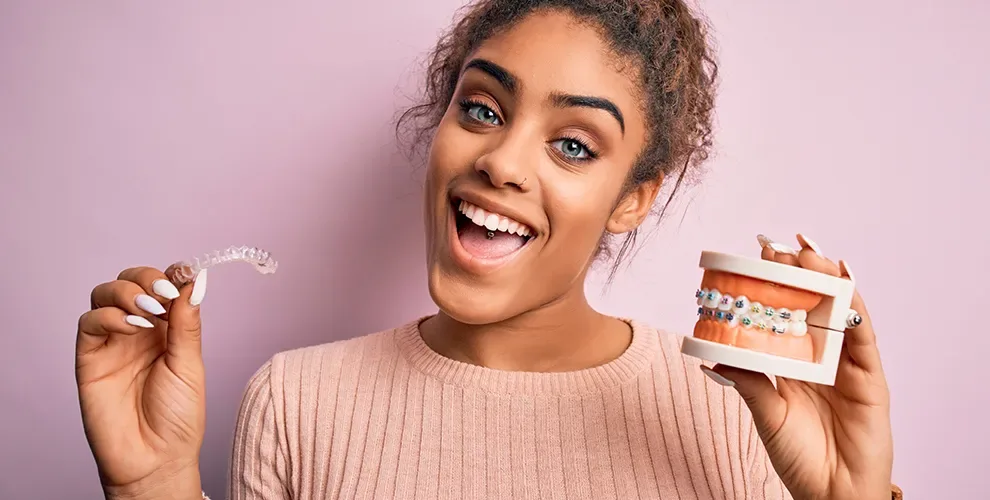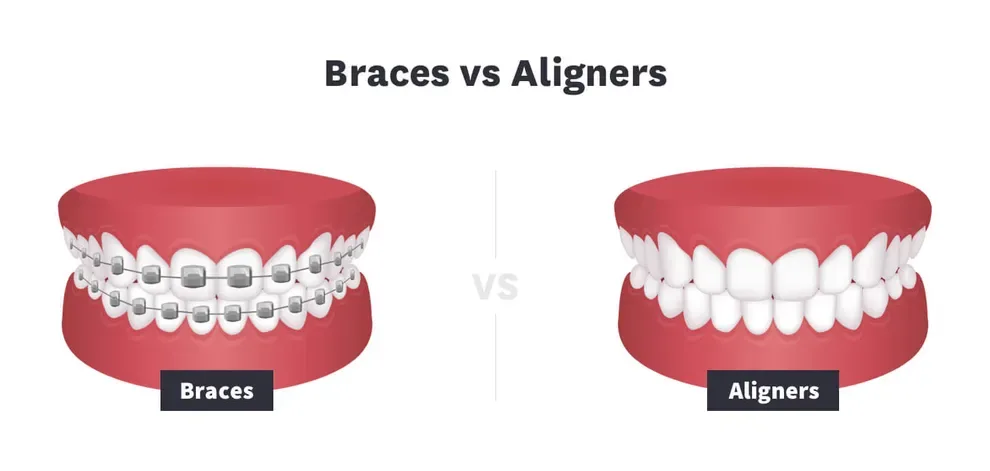Clear Aligners vs. Braces: Everything You Need to Know

Table of Contents
- Conditions Treated
- Treatment Time
- Cleanliness
- Visibility Issues
- Pain Tolerance
- Convenience
- Cost Considerations
- Aligners & Braces?
- Clear Aligners vs. Braces FAQs
Both clear aligners and braces help to straighten your teeth. The devices can also adjust the way your teeth fit together.
Braces are generally best for severe bite problems, says the American Association of Orthodontists (AAO). But you can choose aligners for mild-to-moderate issues. Choose doctor-supervised, at-home aligners like those we offer at Byte, and you'll save time and money.

What's the Difference Between Aligners & Braces?
| Traditional braces | Invisalign aligners | Doctor-supervised, at-home aligners | |
|---|---|---|---|
| Cost | $5,000–$7,500 | $5,000–$7,500 | About $2,000 |
| Conditions treated | Severe malocclusions | Mild to moderate issues | Mild to moderate issues |
| Treatment time | 2 years | 6 months or longer | 4 months |
| Cleanliness | Low; braces aren't removable, and you can't floss | High; aligners are removable | High; aligners are removable |
| Easy to see? | Yes | No | No |
| Comfortable? | Uncomfortable; wires and brackets harm soft tissues | Moderate pain when switching trays | Moderate pain when switching trays |
| Convenient? | No; in-person appointments are mandatory | No; in-person appointments are mandatory | Yes; check in via an app or video chat |
Let's dive into each area in detail, so you'll have all the information you need to make the right decision for your health and your mouth.
Braces
Brackets are glued to the front or back of your teeth, connected by wires. During treatment, the wire gets shorter or bends a bit. The movement pushes your teeth into new positions.
Aligners
Plastic trays wrap around your teeth and push them into new positions. Movements are gentle, and while it can be uncomfortable, this option is often less painful than braces. Swap out trays periodically to move your teeth into new spots.
Conditions Treated: Which is Right?
Both braces and aligners can shift teeth to proper positioning, but they work best for different issues.
Aligners can address the following issues:
Crowding: Your teeth are packed tight inside your mouth, and some don't have enough room.
Gaps: You have spaces between your teeth.
General crookedness: Your teeth just don't look right when you look in the mirror.
Braces are best for the following issues:
Open bite: Your top and bottom teeth don't touch when you close your mouth.
Overbite: Your upper teeth sit too far in front of the lower.
Underbite: Your lower teeth stick out in front of the uppers.
Aligners vs. Braces: What Does the Research Say?
Researchers have examined the performance of aligners vs. braces in treating specific oral health issues. Their work suggests that aligners could be used for plenty of cases, but know that your individual results can vary. Ensure you talk to your doctor about these studies before you use them to guide your care.
Study | Condition examined | Recommend braces? | Recommend aligners? |
Open bite | Yes, as these appliances caused slightly less lower incisor extrusion | Yes, as the overall results were very similar | |
Anterior crowding | Yes | Yes, but many people needed additional aligner trays and bonded retainers | |
Efficacy of aligners in correcting anterior open bite: A systematic literature review | Open bite | Yes, as it offers better control | Yes |
Efficacy of clear aligners in controlling orthodontic tooth movement: A systematic review | Overall tooth movement | Yes, as it’s more accurate and predictable | Limited, especially in people with rounded teeth that need rotation |
Overall tooth movement | Best for severe cases and those that require the specific movement of one or many teeth | Best for mild-to-moderate cases |
Treatment Time: How Long Will It Take?
Braces tend to be more time-consuming than aligners.
Braces: A typical treatment program takes 24 months. Miss an appointment or adjustment, and you'll add time to the plan.
Invisalign: Spend 6 months or longer in treatment. If you miss an appointment, your treatment will take longer.
Byte aligners: Many treatment programs take about 4 months.
Why is the Byte system so fast? Thank HyperByte. Researchers say accelerated orthodontic treatment with vibration is effective, as these vibrating tools speed up bone remodeling and reduce pain.
Use the HyperByte tool (sent with your aligners), and you'll see the results.
When you're living with a better bite, you'll reduce your risk of tooth decay, gum disease, and chewing problems, AAO says.
Cleanliness: How Vulnerable are your Teeth?
You must brush your teeth to keep them clean, whether dental appliances are in use or not. But braces can make cleaning your teeth tough.
Brackets for braces are glued onto your teeth, and wires connect them. This permanent hardware creates spaces that trap bits of food, and when bacteria start feeding, plaque forms. That can lead to tooth decay.
Aligners are different. You take out these devices and clean them when you eat or drink anything other than water.
You can clean your teeth unimpeded. When you have aligners, you don't have to change any of the following:
How you brush your teeth
How you floss your teeth
How you use mouthwash
You simply take out your aligners before you do these things.
Head to the dentist for a cleaning, and you can take out your trays for a full polish and fluoride treatment.
The result is a healthier, cleaner mouth.
Visibility Issues: Do you want your Treatment Noticed?
Modern braces are typically made of metal or ceramic materials, and companies have developed colorful wires and bands to string the teeth together. Some people want to express a personal sense of style with their braces, and they appreciate the color. You may not.
Many people who have orthodontic treatment are self-conscious about their looks. You may feel like any of the following:
People are watching your teeth rather than looking into your eyes
Everyone notices how crooked your teeth are
People make assumptions about your vanity or your health
For the privacy-conscious, aligners are a better choice. The devices are still noticeable for those who look hard, but they don't catch sunlight like metal wires.
You should wear your aligners almost all the time, but if you have a high-pressure situation, such as a job interview, you could take them out. You're in control of your appearance with aligners.
Pain Tolerance: How much Discomfort can you Handle?
Researchers say that people with braces experience a dip in quality of life during the first three months of treatment. That might be caused by a painful adjustment to a mouth filled with braces.
You must grow accustomed to the following with braces:
Chapped lips: Your lips must stretch to make room for the brackets. Your lips might not fully close, resulting in a dryer mouth and lips.
Poking wires and brackets: The brackets stick out from your teeth, often rubbing the inside of your lips. Your devices can also rattle loose, and when that happens, you can get scrapes and sores.
Mouth sores: Welts are common during braces treatment. Wax can help, but your mouth will feel sore and tender until you develop calluses.
Aching with adjustments: When your braces are tightened, you may feel slightly uncomfortable for the next few days as your teeth adjust to the pressure.
Good steps to follow to help you stay comfortable with braces include the following:
Try an over-the-counter pain medication like aspirin.
Use a topical painkiller for direct pain relief. Massage it into your gums in a circular motion for extra pain-killing power.
Apply orthodontic wax to the rough edges of your braces.
Use an ice pack on your cheek or swirl ice water inside your mouth.
Eat soft foods whenever possible.
Rinse with warm water to help heal cuts and sores.
Moving teeth is painful, and both braces and aligners cause that discomfort. But aligners are thin and smooth. They don't pull on your lips, and they don't poke your gums. Your teeth may be sore, but your soft mouth tissues should emerge unscathed.
Both oral and topical painkillers could be helpful in easing aligner discomfort. If you feel like your trays are cutting into your gums, ask your team what to do to make things better.
Convenience: How Much Time Do You Have?
With both aligners and braces, a professional supervises every step in your treatment plan. But braces and Invisalign require in-person appointments. Byte does not.
Opt for braces or Invisalign, and prepare to see your dental health team for periodic checkups and adjustments. That means sitting in a crowded waiting room, hoping your visit will start on time and that you'll be back to work or your daily schedule without much delay.
Choose doctor-monitored, at-home aligners, and you’ll deal with your teeth on your schedule. A doctor will oversee the whole process, ensuring that your treatment plan is designed appropriately and things are moving along as planned. But you won't have to deal with in-person appointments and crowded waiting rooms.
Cost Considerations: How much will you Pay?
Braces cost between $5,000 and $7,500 on average. Invisalign aligners, administered in orthodontic offices in a system similar to braces, also cost up to $7,000.
At-home aligners cost about $2,000. For people looking for the smallest price tag, aligners are clear winners.
You can cut that cost even more with the following:
Dental insurance: Insurance companies can and often do chip in to help families cover the cost of orthodontic care. If you have such a plan, you could pay very little for the care you need.
Health savings accounts: Get tax benefits for saving money to pay for health issues. Use those funds to pay for your dental care.
Discounts: Companies (like Byte) offer discounts to military members and other groups. Pay attention to the deals, and you could knock a bit of money off your price.
No matter how much you pay, remember that you're investing in your smile. The fees are worth your long-term dental health.
Clear Aligners vs. Braces Frequently Asked Questions
Aligners are quick and efficient, and aligner treatment times tend to be shorter than braces treatment times. But braces also work on more complex cases, and those take more time to fix.
At-home, doctor-supervised aligners are much less expensive than traditional braces.
Of course. If your aligner treatment isn't right for you, an orthodontist could apply braces to your teeth.
It depends. Teens with significant dental issues may benefit from braces, while those with mild-to-moderate issues may appreciate aligners.
No. Both braces and aligners pressure your teeth to take up new positions, and that movement can be uncomfortable. Aligners tend to cause less discomfort than braces do, but they’re not entirely pain-free.
Aligners are medical devices that should be applied by a professional. At Byte, we assess your oral health and necessary care before creating your aligners. If we think your issue isn’t right for aligner treatment, we’ll tell you. That decision is based on what’s best for your long-term health, and unfortunately, it’s not negotiable. You may want to use aligners for everything, but it’s not always best for your long-term goals.
Doctors look at your oral health, tooth position, bite, and smile to determine how much your teeth should move. They also examine your willingness to participate in the treatment program and your lifestyle. All of that data helps them determine which option is best for you.
